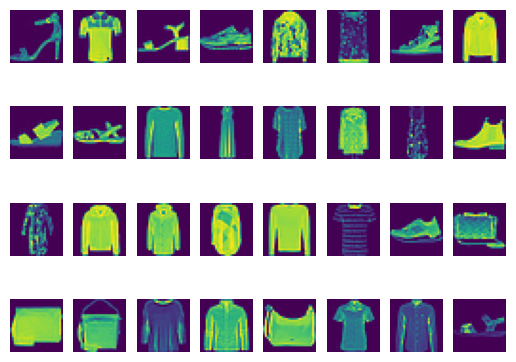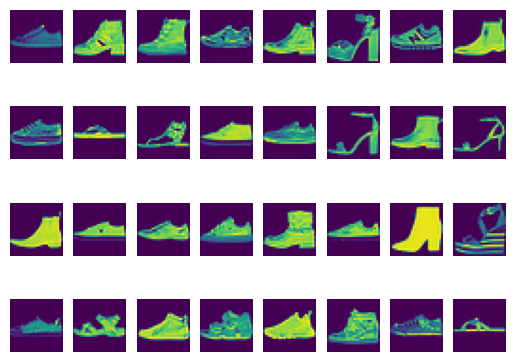How to use a Torchvision dataset in the Grain pipeline#
In this tutorial we’re going to learn how to process and extend Torchvision datasets using Grain on the example of Fashion-MNIST dataset.
Setup#
Here we require grain, torch, and torchvision dependencies installed but
the last will be used primarily for dataset access. Additionally we want
matplotlib in our environment for displaying samples.
%pip install grain
%pip install numpy matplotlib torch torchvision
import grain
import matplotlib.pyplot as plt
import numpy as np
from PIL.Image import Image
import torch
# PyTorch imports
from torchvision import datasets
from torchvision.transforms import Lambda, ToTensor
rng = np.random.default_rng(0)
Loading the dataset with Torchvision#
The Torchvision FashionMNIST function provides access to our dataset. There
are 60k samples in the dataset, where each one of them is a Pillow image
instance together with a label.
fashion_mnist = datasets.FashionMNIST(root="data", train=True, download=True)
print(fashion_mnist)
print(fashion_mnist[0])
fashion_mnist[0][0]
Dataset FashionMNIST
Number of datapoints: 60000
Root location: data
Split: Train
(<PIL.Image.Image image mode=L size=28x28 at 0x72BC7848F1F0>, 9)
100%|██████████| 26.4M/26.4M [00:00<00:00, 60.1MB/s]
100%|██████████| 29.5k/29.5k [00:00<00:00, 1.14MB/s]
100%|██████████| 4.42M/4.42M [00:00<00:00, 20.9MB/s]
100%|██████████| 5.15k/5.15k [00:00<00:00, 13.6MB/s]

In this example, we have an ankle boot (label 9). First we should acknowledge that both sample and label require dedicated preprocessing:
The sample should be a PyTorch tensor;
The label needs to use one-hot encoding, so
9becomes[0,0,0,0,0,0,0,0,0,1].
Let’s inspect a few more samples first.
nrows, ncols = 4, 8
fig, axs = plt.subplots(nrows, ncols)
for x in range(ncols):
for y in range(nrows):
axs[y, x].imshow(fashion_mnist.data[rng.integers(len(fashion_mnist))])
axs[y, x].set_axis_off()

torchvision’s datasets function, which imports the dataset, already offers
transform and target_transform arguments. Let’s confirm that ToTensor and
Lambda do what we anticipate.
fashion_mnist_2 = datasets.FashionMNIST(
root="data",
train=True,
download=True,
transform=ToTensor(),
target_transform=Lambda(
lambda y: torch.zeros(10, dtype=torch.float).scatter_(
0, torch.tensor(y), value=1
)
),
)
(fashion_mnist_2[0][0].size(), fashion_mnist_2[0][1])
(torch.Size([1, 28, 28]), tensor([0., 0., 0., 0., 0., 0., 0., 0., 0., 1.]))
The resulting contents are a PyTorch tensor and a one-hot encoded label, as expected.
Processing the dataset with Grain#
Now let’s move to Grain! Our goal is perform the same transformation on the
dataset as before, but this time using Grain API. You might have noticed in the
Dataset basics tutorial
that defining a data source requires implementing a class that inherits from
grain.sources.RandomAccessDataSource. With PyTorch datasets we don’t need
it - the dataset is already compliant with the protocol.
Next let’s move to the preprocessing stage. We implement a custom class which
inherits from grain.transforms.Map and implements a map method. In this
method we instantiate a PyTorch tensor and devise a one-hot encoded label.
To make this rewrite more compelling, let’s use Grain’s capabilities beyond
simple samples traversal. Assuming that we are interested in shoes only
(labels: 5 - sandals, 7 - sneakers, and 9 - ankle boots) we implement a
Filter class with a filter that allows us to discard unwanted samples.
class ToTensorAndOneHot(grain.transforms.Map):
to_tensor = ToTensor()
def map(
self, element: tuple[Image, int]
) -> tuple[torch.Tensor, torch.Tensor]:
data = self.to_tensor(element[0])
target = torch.zeros(10, dtype=torch.float).scatter_(
0, torch.tensor(element[1]), value=1
)
return (data, target)
class KeepShoesOnly(grain.transforms.Filter):
shoes_only = {5, 7, 9} # Sandal, Sneaker, Ankle boot
def filter(self, element: tuple[Image, int]) -> bool:
return element[1] in self.shoes_only
Complete Pipeline#
Now we combine all pieces into a single pipeline. Grain exposes an API that allows us to rely on a chain of method calls. This results in a straightforward flow from the source to the final batching stage.
dataset = (
grain.MapDataset.source(fashion_mnist)
.shuffle(seed=42)
.filter(KeepShoesOnly()) # leave only shoes
.map(ToTensorAndOneHot()) # construct tensors and label one-hot encoding
.to_iter_dataset()
.batch( # batches consecutive elements
batch_size=5,
batch_fn=lambda ts: tuple(torch.stack(t) for t in zip(*ts)),
)
)
The result is exactly what we expected - both samples and labels are now PyTorch tensors, and they’re batched in groups of five.
iterator = iter(dataset)
batch_0 = next(iterator)
print(type(batch_0[0]), batch_0[0].shape)
print(batch_0[1])
<class 'torch.Tensor'> torch.Size([5, 1, 28, 28])
tensor([[0., 0., 0., 0., 0., 0., 0., 0., 0., 1.],
[0., 0., 0., 0., 0., 1., 0., 0., 0., 0.],
[0., 0., 0., 0., 0., 0., 0., 1., 0., 0.],
[0., 0., 0., 0., 0., 0., 0., 0., 0., 1.],
[0., 0., 0., 0., 0., 0., 0., 0., 0., 1.]])
nrows, ncols = 4, 8
fig, axs = plt.subplots(nrows, ncols)
for x in range(ncols):
data, _ = next(iterator)
for y in range(nrows):
axs[y, x].imshow(data[y, 0])
axs[y, x].set_axis_off()

In the last cell we additionally confirm that all items are restricted to shoes only. The pipeline that we’ve built not only allowed us to ensure Torchvision dataset-loading features, but also extend with batching and filtering capabilities.